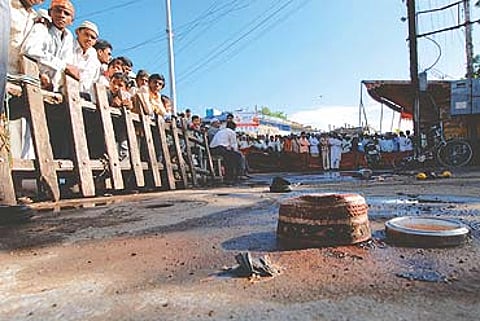Ambush At Mosam Pul
Delays in the Malegaon blasts probe have left locals restive. Theories abound and the communal peace stakes are still shaky.<a > Updates</a>
- Early indications showed a striking similarity with the July 11 Mumbai train blasts. But no clear evidence since pointing to Islamic terrorist groups.
- Could be a plot hatched by a Hindu group. But beyond rounding up 20 persons from a Hindu neighbourhood, there are no clues.
- Links between blasts and arrest of Bajrang Dal men with bombs in Nanded in April being looked into.
- No arrests yet. People have only been picked up for questioning.
- Police in a bind: if it suggests Muslim involvement, then it fears a backlash against the force. If Hindu involvement is spelt out, it might trigger violence against Hindus.
***
The Friday before, four RDX-laden bombs went off near the Hamidiya mosque, Bada Kabristan and Mushaverat Chowk on Shab-e-Barat—when Muslims pray for their dead—and since then the battle for peace has been between the nearly seven lakh people of this powerloom town (70 per cent Muslim) and an as-yet unidentified enemy. The blasts left 31 dead and hundreds injured.
It hasn't helped that the police are yet to announce a breakthrough. Public ire stems from the fact that the week-long investigations has yielded little. There have been detentions and questionings, but no arrests. Even the rounding up of "20 men from a predominantly Hindu area" came five days later. Since that fateful Friday afternoon, this is what the police claim to have: a few suspects detained for questioning, sketches of three men based on eye-witness accounts, one of the two bomb-laden, damaged bicycles, statements from dealers who sold the two cycles and a host of theories.

Early evidence pointed to striking parallels with the July 11 Mumbai train blasts. But sources say the ground evidence is hardly credible—first the fleeing crowds in Malegaon disturbed the crime scene and later, angry mobs prevented police personnel from cordoning off the sites. Even so, the police unwillingness to offer even routine suspicions about the perpetrators, assumptions that were offered within hours of the blasts in Mumbai, hasn't gone down well. "We're not even told who the perpetrators could be. They are hiding something," remarked cloth merchant Mohammed Khan Ibrahim Khan, emerging from one of the many mass memorial prayers.
If the investigators—local police backed by the Anti-Terrorist Squad of Maharashtra police—are to be believed, the September 8 blasts too "resemble the handiwork of Islamic terrorist organisations". However, this begs the obvious query: why would Muslim terrorists want to place bombs in and around a masjid? If investigators are exploring the possibility of it being a sinister plan of Hindutva outfits, they are making little headway. In fact, some of them rule out the involvement of outfits like the Bajrang Dal whose two members were killed while handling bombs at an activist's home at Nanded this April.

In the absence of concrete progress in the probe, theories abound on both sides of the Mosam Pul, the bridge that connects the town's Hindu and Muslim quarters. Muslims say the investigation is discriminatory, that the cops are not trailing the "fake beard" link. A tailor near Bada Kabristan, Aqeel Ahmed Ansari, said he had picked up a body from near one of the damaged bicycles and handed it over to volunteers in an ambulance. The lower part of the torso had been blown away, but the beard had come off while moving it to the ambulance. The inference: that it was a fake beard and therefore the body of a perpetrator. The "fake beard" theory assumes significance here only because several fake beards, Muslim headgear etc were recovered from the house of the Bajrang Dal activist in the Nanded case.

Days after the Malegaon blasts, police in Nashik and Jalgaon recovered explosives, gelatin sticks and ammunition from several places. Reports of arms caches being found in cities of northern Maharashtra have now become commonplace. Taken together with the fact that the state has seen more than 110 bombings in the last 5-6 years, each haul assumes significance. Suddenly, Maharashtra looks like the new theatre of terror.
Malegaon, with its troubled track-record, would perhaps be the ideal stage for it too. The economy, based almost exclusively on the loom, took a beating when the sector began its downslide some 20 years ago. Now there isn't a single industry worthy of note here. The literacy rate is barely 56 per cent compared to the state average of 79 per cent. Hospitals, colleges, technical institutes, maidans all seem caught in a 1960s time-warp. Half of the population (around 3.5 lakh) lives in slums. There is frustration all around.

The politicians have done little. Nihal Ahmed, 80, as MLA was the uncrowned king for decades; a socialist turned Hindu-basher, he concentrated more on ration cards than development projects. This time when he tried to milk the situation at a public meeting, he was all but hooted out. The public ire was apparent at a meeting after the blasts when some of the affected families returned the compensation cheques to Sonia Gandhi.
A less perceptible change is in the Muslim mindset itself—from perpetrator to victim. There are people here who believe "their children died so that Islam could be cleansed of the stain that it harbours terrorists". In a town wracked with real and imagined divisions, new fissures are emerging. The Konkani or Maharashtrian Muslim has been increasingly crowded by those coming from UP and Bihar. The small houses are aclutter, the cinema houses—old halls showing old movies—always packed. There are few jobs and the men hang around outside their homes, on the streets, at chowks. A mob is then just a shout away. And, violence merely across the bridge. Strangely, that's why in Malegaon even a fragile peace is commendable.
Tags